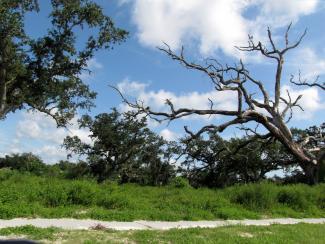Passed on August 16, 2022, the Inflation Reduction Act commits nearly $370 billion in direct investment to address climate change and energy production. The largest federal investment in climate change to date, the IRA funds a variety of climate and energy-related initiatives and is predicted to put the United States on track to reduce carbon emissions by about 40% by 2030.

With its wide scope and vast funding for federal, tribal, state, and local climate initiatives, the IRA has the potential to touch nearly everything we do at ELI. For example, I work with a project team researching policy and legal levers to help facilitate implementation of large-scale nature-based solutions for flood mitigation along the Mississippi River. Since Executive Order 14072: Strengthening the Nation’s Forests, Communities, and Local Economies identified nature-based solutions as an important mechanism for building climate resilience, we hope the IRA can be used to support their implementation. To better understand the IRA’s implications for nature-based solutions, we started by identifying potential funding opportunities within its climate resilience, restoration, and permitting provisions.
Natural Infrastructure
While Executive Order 14082: Implementation of the Energy and Infrastructure Provisions of the Inflation Reduction Act of 2022 states the IRA will harness nature-based solutions, the IRA has no direct reference to nature-based solutions and only one reference to natural infrastructure. Natural infrastructure is considered an allowable use of funds for the Federal Highway Administration’s Neighborhood Equity Grant Program. Underserved communities will be able to use this competitive grant program to fund natural infrastructure for stormwater management or urban heat island mitigation.
Restoration Funding
Natural and nature-based solutions could be implemented through IRA programs to facilitate restoration of natural ecosystems such as wetlands and floodplains. The IRA provides $200 million for vegetation management projects on National Forest System land. The definition of vegetation management includes “reestablishing native vegetation, restoring any natural drainage, and watershed function for areas damaged or negatively impacted by roads.” In addition, about $2.6 billion is allocated to the National Oceanic and Atmospheric Administration for protection of marine and costal habitats and resources as well as helping coastal communities prepare for extreme storms.
Resilience Funding
While NOAA’s funding is focused on coastal resilience, there also are opportunities in the IRA to make inland communities more resilient. There are climate resilience provisions that could be used to fund nature-based solutions for flood mitigation, which are a well-documented climate resilience mechanism. One such opportunity is the Environmental Justice Community Block Grant program. The program appropriates $2.8 billion through September 2026 to disadvantaged communities (as defined by the EPA Administrator) for a number of eligible activities, including climate resiliency and adaptation projects. At the federal level, the U.S. Fish and Wildlife Service received $121,250,000 to promote habitats’ resilience to extreme weather events.
Permitting & Environmental Review Development
Federal permitting and environmental review requirements can serve as barriers to implementing large-scale nature-based solutions. The IRA provides significant funding for several agencies to improve their processes. The Council on Environmental Quality, Department of the Interior, Department of Energy, Environmental Protection Agency, Federal Highway Administration, Federal Energy Regulatory Commission, and NOAA all received funds. DOI received the largest pot of money at $150 million, followed closely by DOE and FERC with $115 million and $100 million respectively. While there are slight variations in how each agency can use these funds, the money can generally be used for training personnel, improving public engagement, providing technical assistance, developing tools to facilitate environmental review, and purchasing new equipment.
The Federal Permitting Improvement Steering Council Environmental Review Improvement Fund received $350 million that will be available from 2023 to 2031. At about $44 million per year, this funding is a significant jump from the $10.65 million the Steering Council requested to cover its work in 2022. The IRA does not have any requirements for how this funding must be used, so it will be important to keep an eye on how this increase in funding affects current federal practices.
Moving Forward
Although nature-based solutions received no direct mention in the IRA, there is ample opportunity for IRA funding to support projects at the federal, state, local, and tribal levels. Yet just because there’s opportunity does not mean there will be implementation. It will be up to decisionmakers at all levels whether these opportunities are leveraged. If the Biden Administration hopes to follow through on its stated commitment to nature-based solutions, providing guidance and education on how to use IRA funding for these projects will be crucial to providing myriad benefits to the nation’s ecosystem restoration, flood mitigation, and climate resilience efforts.
